-
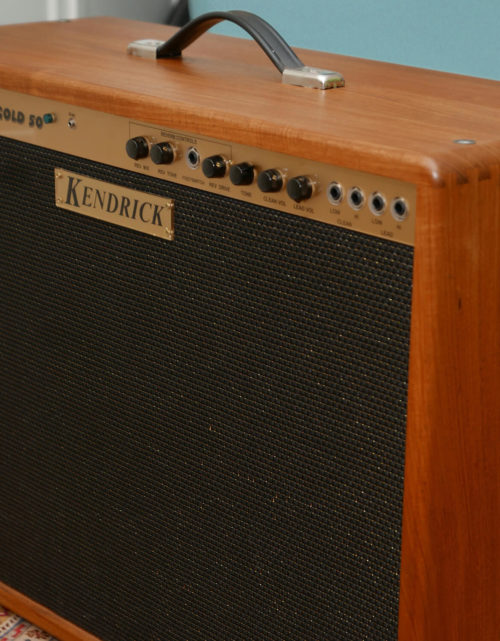 This was one of the best amps ever made by the legendary Gerald Weber. All-tube circuitry, designed and made in the USA, by Weber. It not only has power to spare (50 watts), but its unique circuitry has two channels, clean and lead, with different preamp circuit. These channels can be blended through patching the second input of one channel into the first input of the other, for purposes of blending the two channels together and further tone shaping with the interactive tone circuit. The bottom line: Tons of power if you need it, but the ability to get all the creamy, lush lead tones with the lead channel and/or blending. You just have to hear it. Original, handmade hardwood cabinet. 2 x 12: one 12 inch Kendrick brown frame and one 12 inch Kendrick black frame speaker. Kendrick's double spring reverb with three controls. Great condition. Recently serviced by one of the best amp techs in Texas. Price: $1495. No shipping. Local pickup only in Austin.
This was one of the best amps ever made by the legendary Gerald Weber. All-tube circuitry, designed and made in the USA, by Weber. It not only has power to spare (50 watts), but its unique circuitry has two channels, clean and lead, with different preamp circuit. These channels can be blended through patching the second input of one channel into the first input of the other, for purposes of blending the two channels together and further tone shaping with the interactive tone circuit. The bottom line: Tons of power if you need it, but the ability to get all the creamy, lush lead tones with the lead channel and/or blending. You just have to hear it. Original, handmade hardwood cabinet. 2 x 12: one 12 inch Kendrick brown frame and one 12 inch Kendrick black frame speaker. Kendrick's double spring reverb with three controls. Great condition. Recently serviced by one of the best amp techs in Texas. Price: $1495. No shipping. Local pickup only in Austin. -
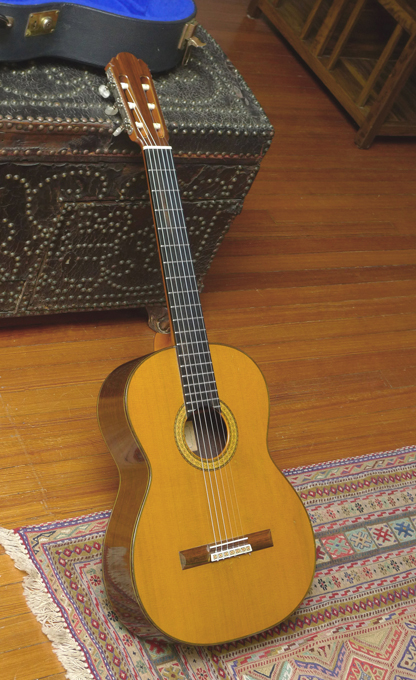 Another fine Kohno classical guitar from Masaru Kohno. This one combines a cedar top with Indian rosewood back and sides for a warm, clear tone. The best sounding Kohno 15 (or 20 for that matter) we’ve had.
Another fine Kohno classical guitar from Masaru Kohno. This one combines a cedar top with Indian rosewood back and sides for a warm, clear tone. The best sounding Kohno 15 (or 20 for that matter) we’ve had.- Cedar Top
- Indian Rosewood Back and sides
- Ebony Fretboard
- Deluxe Fustero tuners, with pearloid buttons
- Scale length: 660mm
- Nut: 52mm
- Condition is good. Several repaired cracks, all well-repaired:
- treble side, about 1/4 inch off fretboard: 3 2/3 inch
- bass side, 1 1/4 inch off fretboard: 4 ¼ inch
- 1/4 inch bass side of center seam, between bridge and soundhole: 4 inches
-
 We called it the “Tony Rice” prewar 000-18. Is it the "tony rice" style slightly enlarged soundhole (done decades ago). All original finish.
We called it the “Tony Rice” prewar 000-18. Is it the "tony rice" style slightly enlarged soundhole (done decades ago). All original finish. -
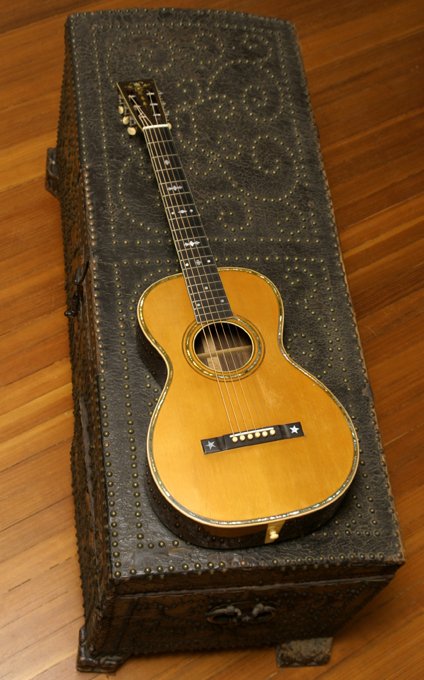 The Larson Brothers of Chicago began making steel string guitars earlier than did Martin, with their own ideas not tied to the past, and their designs are now considered by both players and collectors to be uniquely beautiful, wonderful for tone, and highly desirable. And they are much more rare guitars than Martin or Gibson– and more ornate than either Gibson or the always conservative Martin. Tone: think of a Martin Brazilian Rosewood 0-sized 12 fret from the 20’s, but add much more sustain. It vibrates in your hands, and because of Larson’s patented “built under tension” design, is thought of by players and collectors as being both unique and generating more sustain than you’ll get from any other guitar ever made. But the tone of Larsons (even the larger bodied-ones) is more treble-weighted than a Martin from the same era, so that this extra sustain does not result in a muddled sound– more like a magical shimmer and sustain that really brings out the mid- and treble-side Brazilian tone. Every part of this guitar is original. Guitar is crack-free. The bridge, never having been off the guitar, was at some point decades ago shaved slightly on top to lower the action. We have decided to keep this original bridge in place and not install a repro bridge–action is good, and the neck is straight. This particular model, is one of the very high end Larson models, with its Abalone trim, elaborate inlays on headstock and fretboard, and exquisite book-matched Brazilian rosewood back.
The Larson Brothers of Chicago began making steel string guitars earlier than did Martin, with their own ideas not tied to the past, and their designs are now considered by both players and collectors to be uniquely beautiful, wonderful for tone, and highly desirable. And they are much more rare guitars than Martin or Gibson– and more ornate than either Gibson or the always conservative Martin. Tone: think of a Martin Brazilian Rosewood 0-sized 12 fret from the 20’s, but add much more sustain. It vibrates in your hands, and because of Larson’s patented “built under tension” design, is thought of by players and collectors as being both unique and generating more sustain than you’ll get from any other guitar ever made. But the tone of Larsons (even the larger bodied-ones) is more treble-weighted than a Martin from the same era, so that this extra sustain does not result in a muddled sound– more like a magical shimmer and sustain that really brings out the mid- and treble-side Brazilian tone. Every part of this guitar is original. Guitar is crack-free. The bridge, never having been off the guitar, was at some point decades ago shaved slightly on top to lower the action. We have decided to keep this original bridge in place and not install a repro bridge–action is good, and the neck is straight. This particular model, is one of the very high end Larson models, with its Abalone trim, elaborate inlays on headstock and fretboard, and exquisite book-matched Brazilian rosewood back.- Year: 1926
- Model: 562
- Serial number: 31778
- This is the Maurer Larson Brothers “Standard size”: lower bout width: 12 3/4 inches
- Brazilian rosewood back and sides
- Spruce top
- Larson's “laminated” X braces. This is the patented Larson Brothers’ bracing, with each brace being Spruce/Rosewood/Spruce
- Larson’s patented “built under tension” design
- Trim: Abalone pearl and herringbone bordering the top and sound hole
- Torch-style pearl headstock inlay
- Radiused ebony fingerboard, and Classic Larson Brothers’ “ebony below the binding”
- Engraved inlays on fretboard
- Original Engraved Waverly tuners
- Original Ivory bridge pins
- 1-7/8" wide nut
- 2-5/16" bridge string spacing
- 24.5" scale length
- One-piece mahogany neck, round C shaped neck profile.
-
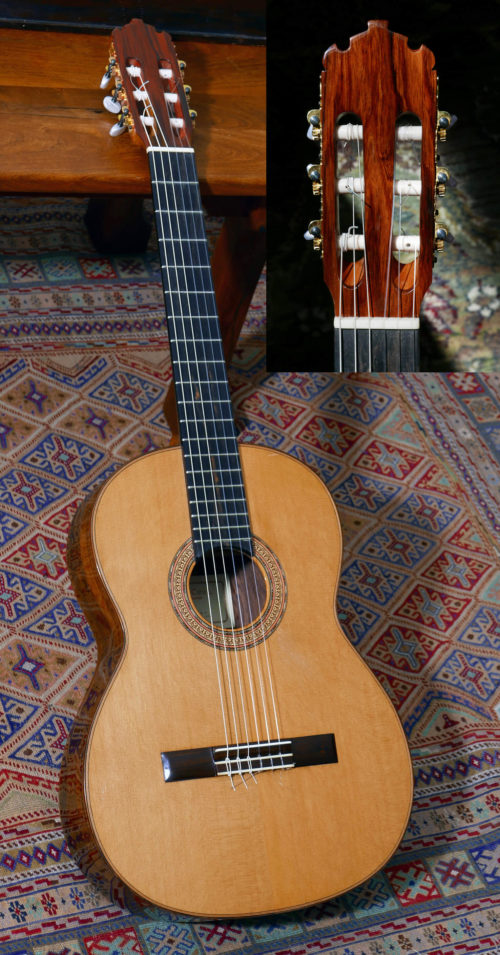 Acquired from the original owner – who bought this wonderful instrument directly from David Caro in the mountain town of the maker, one of the best luthiers that Paracho, Mexico has ever produced – in the mid 90’s and hand-carried it to California where it was lightly played. And it remains in remarkable original condition. The maker is David Caro, also known as David Caro Leonardo, or David Caro L. (In Mexico, the last/last name, in this case “Leonardo”, is the mother’s maiden name that is formally added after a person’s last [paternal] name but typically dropped in all but formal situations, documents etc.) Caro’s best instruments are among the best of a small, elite group that honed their craft at the top levels, and also benefited from visits and master classes given in Paracho by some world class luthiers from Spain, Germany, and the USA such as Felix Manzanero, Antonio Raya Pardo, Jose Romanillos, Thomas Humphery, and Herman Hauser III. Only a few Paracho luthiers have stood out over the years – Jose Navarro, Arturo Huipe, Abel Garcia, Enos Hernandez (his best work), German Vasquez Rubio, and Caro among them. See the enclosed photos from Fretboard Journal magazine, Spring 2008, that featured David Caro prominently in the feature article in that issue on Paracho luthiers. Paracho is an originally Tarascan village that sits in a high valley at 7,300 feet altitude, in the state of Michoacán, a relatively little visited state but renowned for its diversity and great beauty – and for some of the best classical guitar luthiers in the Americas. It extends from the Pacific coast, and is crossed by the Sierra Madre Del Sur in its southern part and by high volcanic mountains in its northern axis. When this guitar was made, in 1996, David Caro was at the height of his craft. And soon after, he was the first luthier to be added to the GSA calendar. This instrument is among the very best guitars ever made by Caro. And we love the model designation, it’s signed by hand on the label, “Mdo. 500”, i.e. “model 500” – sounds like a sports car name. Model 500 was the top model from Caro, in 1995/96 – using top woods, and also the best bindings, and all details. In those years, Caro’s best concert instruments went from model 100 at the base level, then ascending in tone woods and overall construction details to 200, 300, 400, then reaching the top level of “500”. So we’re calling this instrument, “el Quinientos”. (Spanish for “the 500” – nice ring to that – it’s pronounced “key-knee-éntose”) Several things make this guitar stand out as a gem: • It’s the top model from this luthier in the 1990’s • The great original condition • Scale length of 648mm. This scale length is reminiscent of Herman Hauser I’s guitars, and is firmly in the school of the shorter 650 range, not the longer scale lengths that crept in, in the last quarter of the 20th century. This is a great scale length – and note the nut width is a typical nut width of a full size classical guitar. And the neck thickness is great – on the thinner side. This combination makes it a joy to play and so easy to play – but the tone is superb. The full tone, and volume are better than most longer scale guitars. • Light weight/construction, that really allows it to sing. Its total weight, with strings, is a remarkably lithe 1430 grams • And it has great combination of woods: • Palo Escrito back and sides, bridge, and headplate veneer. DALBERGIA PALOESCRITO, is a true rosewood, a great wood that over the years came to be favored by the top luthiers in Paracho – for their top models. It sounds like Brazilian rosewood, but a tad different, and it’s not as “dark” in tone as Indian rosewood. Palo Escrito is lighter in weight and density than either brazilian or Indian rosewood. And weight, is of course part of the equation of a guitar that does translate to tone. Palo Escrito makes this guitar really breathe, and resonate. The lighter weight of this guitar is its charm, that translates to tone – slightly more airy and open, less “closed”, and with full round basses. The tone is clear, with superb string separation, as from the best spruce over rosewood guitars. Surprising volume – but it perhaps produces the best tone, in more delicate playing where you want each note to stand out – that’s of course called good “string separation”: the notes in a run or chord don’t all “blend together” but each note is discernable. And we think it’s accurate to say that this guitar, with its light weight and 648 scale length and combination of woods, has a tone that leans to a great Flamenco negra tone. Fast attack on the trebles, with a touch of growl in the bass when you play them hard. Yet the guitar responds very well to a light touch as well. If you’re looking for another ho-hum, non-descript spruce over Indian rosewood classical tone, this instrument is not for you. • Spruce top – European Alpine spruce • Ebony fingerboard • Ebony reinforcing strips, back of neck • Ebony heel cap • Beautiful rosette, with a hearts & rope pattern (another homage to Bernabe). • Palo Escrito is also used in the binding, back center strip, tie block, and purfling • The headstock shape is an homage to Paulino Bernabe. • Fan strutting, with 5 braces. The braces are very thin, and also scalloped – contributing to the great tone of the instrument. The scale length of the guitar, if it's not on the longer side, allows the luthier to be use more delicate bracing, adding to tone. (Longer scale length guitars produce more tension on the top due to the higher string tension inherent in a longer scale, so luthiers typically have to brace more strongly with longer scale lengths.) • And there is unique, 2-rosewood cleat application under the bridge – one cleat added by Caro at time of construction, on either end of the bridge, on the underside of top, for stability of the top wood beneath the bridge ends. It's worked well. • Good saddle height– and the neck is very straight, and there will never be any neck bowing issues or issue with too high action. Condition: 100% crack-free All original, thin lacquer finish Frets, and fretboard show very little wear A few nicks and dings, and a small amount of fingernail marks in the “pick guard” area. Overall, the condition is what you’d expect from an instrument that’s been played, carefully, for maybe a year, not 20+ years. But the tone is aged, open, clear – benefiting from more than two decades of aging and drying of the woods. Scale length: 648mm Nut Width: 52mm (2 2/32 inches) String spacing at nut: 45mm (1 ¾ inches) Width at lower bout: 14 ¼ inches Body depth, at bottom: 4 inches Body depth, at neck/body joint: 3 ¾ inches Weight (fully strung): 1430 grams (3.15 pounds) In a modern, hard shell case. Price: $4,750.
Acquired from the original owner – who bought this wonderful instrument directly from David Caro in the mountain town of the maker, one of the best luthiers that Paracho, Mexico has ever produced – in the mid 90’s and hand-carried it to California where it was lightly played. And it remains in remarkable original condition. The maker is David Caro, also known as David Caro Leonardo, or David Caro L. (In Mexico, the last/last name, in this case “Leonardo”, is the mother’s maiden name that is formally added after a person’s last [paternal] name but typically dropped in all but formal situations, documents etc.) Caro’s best instruments are among the best of a small, elite group that honed their craft at the top levels, and also benefited from visits and master classes given in Paracho by some world class luthiers from Spain, Germany, and the USA such as Felix Manzanero, Antonio Raya Pardo, Jose Romanillos, Thomas Humphery, and Herman Hauser III. Only a few Paracho luthiers have stood out over the years – Jose Navarro, Arturo Huipe, Abel Garcia, Enos Hernandez (his best work), German Vasquez Rubio, and Caro among them. See the enclosed photos from Fretboard Journal magazine, Spring 2008, that featured David Caro prominently in the feature article in that issue on Paracho luthiers. Paracho is an originally Tarascan village that sits in a high valley at 7,300 feet altitude, in the state of Michoacán, a relatively little visited state but renowned for its diversity and great beauty – and for some of the best classical guitar luthiers in the Americas. It extends from the Pacific coast, and is crossed by the Sierra Madre Del Sur in its southern part and by high volcanic mountains in its northern axis. When this guitar was made, in 1996, David Caro was at the height of his craft. And soon after, he was the first luthier to be added to the GSA calendar. This instrument is among the very best guitars ever made by Caro. And we love the model designation, it’s signed by hand on the label, “Mdo. 500”, i.e. “model 500” – sounds like a sports car name. Model 500 was the top model from Caro, in 1995/96 – using top woods, and also the best bindings, and all details. In those years, Caro’s best concert instruments went from model 100 at the base level, then ascending in tone woods and overall construction details to 200, 300, 400, then reaching the top level of “500”. So we’re calling this instrument, “el Quinientos”. (Spanish for “the 500” – nice ring to that – it’s pronounced “key-knee-éntose”) Several things make this guitar stand out as a gem: • It’s the top model from this luthier in the 1990’s • The great original condition • Scale length of 648mm. This scale length is reminiscent of Herman Hauser I’s guitars, and is firmly in the school of the shorter 650 range, not the longer scale lengths that crept in, in the last quarter of the 20th century. This is a great scale length – and note the nut width is a typical nut width of a full size classical guitar. And the neck thickness is great – on the thinner side. This combination makes it a joy to play and so easy to play – but the tone is superb. The full tone, and volume are better than most longer scale guitars. • Light weight/construction, that really allows it to sing. Its total weight, with strings, is a remarkably lithe 1430 grams • And it has great combination of woods: • Palo Escrito back and sides, bridge, and headplate veneer. DALBERGIA PALOESCRITO, is a true rosewood, a great wood that over the years came to be favored by the top luthiers in Paracho – for their top models. It sounds like Brazilian rosewood, but a tad different, and it’s not as “dark” in tone as Indian rosewood. Palo Escrito is lighter in weight and density than either brazilian or Indian rosewood. And weight, is of course part of the equation of a guitar that does translate to tone. Palo Escrito makes this guitar really breathe, and resonate. The lighter weight of this guitar is its charm, that translates to tone – slightly more airy and open, less “closed”, and with full round basses. The tone is clear, with superb string separation, as from the best spruce over rosewood guitars. Surprising volume – but it perhaps produces the best tone, in more delicate playing where you want each note to stand out – that’s of course called good “string separation”: the notes in a run or chord don’t all “blend together” but each note is discernable. And we think it’s accurate to say that this guitar, with its light weight and 648 scale length and combination of woods, has a tone that leans to a great Flamenco negra tone. Fast attack on the trebles, with a touch of growl in the bass when you play them hard. Yet the guitar responds very well to a light touch as well. If you’re looking for another ho-hum, non-descript spruce over Indian rosewood classical tone, this instrument is not for you. • Spruce top – European Alpine spruce • Ebony fingerboard • Ebony reinforcing strips, back of neck • Ebony heel cap • Beautiful rosette, with a hearts & rope pattern (another homage to Bernabe). • Palo Escrito is also used in the binding, back center strip, tie block, and purfling • The headstock shape is an homage to Paulino Bernabe. • Fan strutting, with 5 braces. The braces are very thin, and also scalloped – contributing to the great tone of the instrument. The scale length of the guitar, if it's not on the longer side, allows the luthier to be use more delicate bracing, adding to tone. (Longer scale length guitars produce more tension on the top due to the higher string tension inherent in a longer scale, so luthiers typically have to brace more strongly with longer scale lengths.) • And there is unique, 2-rosewood cleat application under the bridge – one cleat added by Caro at time of construction, on either end of the bridge, on the underside of top, for stability of the top wood beneath the bridge ends. It's worked well. • Good saddle height– and the neck is very straight, and there will never be any neck bowing issues or issue with too high action. Condition: 100% crack-free All original, thin lacquer finish Frets, and fretboard show very little wear A few nicks and dings, and a small amount of fingernail marks in the “pick guard” area. Overall, the condition is what you’d expect from an instrument that’s been played, carefully, for maybe a year, not 20+ years. But the tone is aged, open, clear – benefiting from more than two decades of aging and drying of the woods. Scale length: 648mm Nut Width: 52mm (2 2/32 inches) String spacing at nut: 45mm (1 ¾ inches) Width at lower bout: 14 ¼ inches Body depth, at bottom: 4 inches Body depth, at neck/body joint: 3 ¾ inches Weight (fully strung): 1430 grams (3.15 pounds) In a modern, hard shell case. Price: $4,750. -
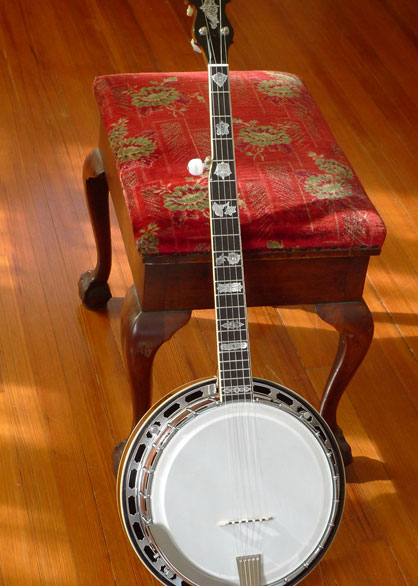 Late 1970s, but in almost unplayed condition. Bluegrass banjo players seek out these 70’s Whyte Eagles, known for their tone and craftsmanship. It was a pretty short window of only about five years, when these banjos were made with this kind of craftsmanship. They blow away most any banjo made and marketed (from any country) in the 60s, 70s and 80s– and they show no logos on headstock– just beautiful mother of pearl. It’s the No. 4310 “Whyte Eagle”. Based on late 1920’s Vega Griffin (Tubaphone #9) style inlays, with engraved, carved heel. Sunburst finish maple banjo, Gibson-style 2 piece flange, full height 20 hole archtop tone ring, dual coordinator rods, flamed maple resonator, maple neck, chrome finish. Neck is butterfly with ebony strip on back of neck, down the center. Just set up, with new tailpiece, and new head, by Dave Trexle and ready to play: loud, clear, and bright. With original hard shell case.
Late 1970s, but in almost unplayed condition. Bluegrass banjo players seek out these 70’s Whyte Eagles, known for their tone and craftsmanship. It was a pretty short window of only about five years, when these banjos were made with this kind of craftsmanship. They blow away most any banjo made and marketed (from any country) in the 60s, 70s and 80s– and they show no logos on headstock– just beautiful mother of pearl. It’s the No. 4310 “Whyte Eagle”. Based on late 1920’s Vega Griffin (Tubaphone #9) style inlays, with engraved, carved heel. Sunburst finish maple banjo, Gibson-style 2 piece flange, full height 20 hole archtop tone ring, dual coordinator rods, flamed maple resonator, maple neck, chrome finish. Neck is butterfly with ebony strip on back of neck, down the center. Just set up, with new tailpiece, and new head, by Dave Trexle and ready to play: loud, clear, and bright. With original hard shell case. -
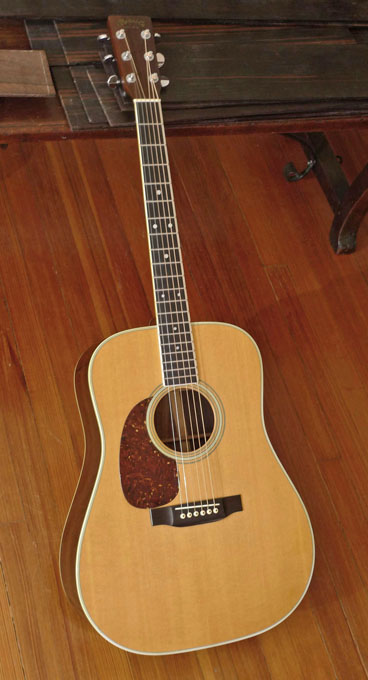 This is a wonderful, original from the factory "Lefty", a 1975 D-35L. Lefty's from this period are rare. Before the era of computerized factories, and the intro of the CNC machines at Martin, a high-end Lefty like this one was essentially a custom-made guitar. The bracing in this guitar was custom designed and built at the Martin factory for a true lefty top– this is not a regular D-35 with just different saddle and pickguard. It's built as a left-handed guitar, down to every brace. This guitar is in about as close to mint condition as you can get. The original black pickguard was lifting a bit (not from wear, there wasn't any– but just because Martin used some odd pickguard material in those years), so we just thought it would be cool to replace it with a vintage 30s style tortoise guard. I had John Allison cut a new guard, using period correct (1930's that is) nitrocellulose material. It looks great. (and BTW it's on the exact footprint of the original guard– they nudged them up a bit closer to the bridge on lefty's). This guitar sounds great. Fine, ringing trebles. Beautiful mids. It's one of the best D-35's we've played, from any period. And again, the condition is just almost mint. No cracks. No checking of finish. Everything except the pickguard is 100% original. It comes in its original hard shell Martin case, and original Martin literature from the Factory. The neck is straight, and action is perfect.
This is a wonderful, original from the factory "Lefty", a 1975 D-35L. Lefty's from this period are rare. Before the era of computerized factories, and the intro of the CNC machines at Martin, a high-end Lefty like this one was essentially a custom-made guitar. The bracing in this guitar was custom designed and built at the Martin factory for a true lefty top– this is not a regular D-35 with just different saddle and pickguard. It's built as a left-handed guitar, down to every brace. This guitar is in about as close to mint condition as you can get. The original black pickguard was lifting a bit (not from wear, there wasn't any– but just because Martin used some odd pickguard material in those years), so we just thought it would be cool to replace it with a vintage 30s style tortoise guard. I had John Allison cut a new guard, using period correct (1930's that is) nitrocellulose material. It looks great. (and BTW it's on the exact footprint of the original guard– they nudged them up a bit closer to the bridge on lefty's). This guitar sounds great. Fine, ringing trebles. Beautiful mids. It's one of the best D-35's we've played, from any period. And again, the condition is just almost mint. No cracks. No checking of finish. Everything except the pickguard is 100% original. It comes in its original hard shell Martin case, and original Martin literature from the Factory. The neck is straight, and action is perfect. -
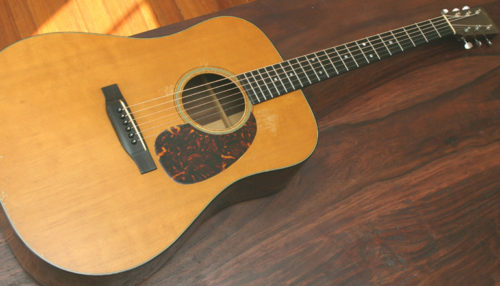 This big booming dreadnaught from one of Martin’s finest eras has everything you’d expect in volume, but it also has that wonderful sustain and ringing treble, and warm round bass, that only an almost-50-year-old Brazilian Rosewood Martin dreadnaught brings. All original throughout. Small 3 inch finish crack on lower back, stable. Typical B-string/pickguard crack, difficult to see, from bridge to beneath guard. Great original finish with minor dings and some minor pickwear around the soundhole. Ivory nut, full, original bridge and perfect condition maple bridge plate. The frets are in great condition. Rosewood fingerboard shows slight wear, nothing out of the ordinary. Frets are fine, showing minimal wear. Beautiful tortoiseshell binding in great condition, no separation anywhere. Inside of guitar shows all braces perfect–very clean and dust-free inside. Strap lug on heel and endpin. The neck was just set by Tony Nobles, and the action is low, with no buzzing. You can play it hard. It was fitted with a new bone saddle with the neck set (the original ivory saddle is in the case). Brazilian rosewood D-size Martins, from the era when Martin still used hide glue for guitar construction, are highly sought-after. This one, in this condition, will go quickly.
This big booming dreadnaught from one of Martin’s finest eras has everything you’d expect in volume, but it also has that wonderful sustain and ringing treble, and warm round bass, that only an almost-50-year-old Brazilian Rosewood Martin dreadnaught brings. All original throughout. Small 3 inch finish crack on lower back, stable. Typical B-string/pickguard crack, difficult to see, from bridge to beneath guard. Great original finish with minor dings and some minor pickwear around the soundhole. Ivory nut, full, original bridge and perfect condition maple bridge plate. The frets are in great condition. Rosewood fingerboard shows slight wear, nothing out of the ordinary. Frets are fine, showing minimal wear. Beautiful tortoiseshell binding in great condition, no separation anywhere. Inside of guitar shows all braces perfect–very clean and dust-free inside. Strap lug on heel and endpin. The neck was just set by Tony Nobles, and the action is low, with no buzzing. You can play it hard. It was fitted with a new bone saddle with the neck set (the original ivory saddle is in the case). Brazilian rosewood D-size Martins, from the era when Martin still used hide glue for guitar construction, are highly sought-after. This one, in this condition, will go quickly. -
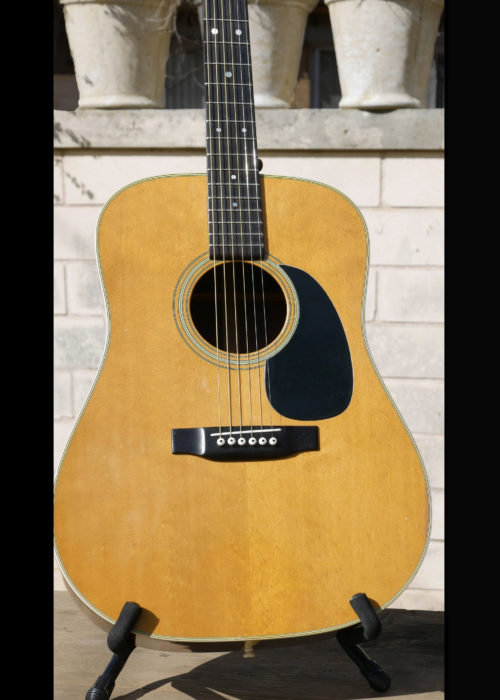 Many players consider the best Martin D-28’s from the 70’s great guitars– and the best value around if you want a vintage D-28 on a budget. The best ones deliver great tone– a darker, richer voice than 50's or 60’s D-28’s. The non-adjustable truss rod, and great Indian rosewood Martin used in those years, and the nice bear claw sitka on top on this example, all make for a lovely instrument. A few nicks and dings, but in remarkable original condition. This instrument delivers. It’s all original, and it’s 100% crack-free (not even the common “pickguard crack”). The original pickguard is not lifting as you often see on these Martins. Original bridge that's never been off the guitar, pins, everything. It has the typical slight finish crazing on top, visible from an angle– it’s common on this vintage. The neck has never been set. Frets in fine shape. Original Grovers. With a low-ish saddle, it plays fine. And in tune everywhere. At some point in the future the new owner may want to do a neck set, but we prefer to keep it all original (and the action is fine as is). ... no longer available – see the newly listed 1970 Martin D-28 in the Featured Instruments section.
Many players consider the best Martin D-28’s from the 70’s great guitars– and the best value around if you want a vintage D-28 on a budget. The best ones deliver great tone– a darker, richer voice than 50's or 60’s D-28’s. The non-adjustable truss rod, and great Indian rosewood Martin used in those years, and the nice bear claw sitka on top on this example, all make for a lovely instrument. A few nicks and dings, but in remarkable original condition. This instrument delivers. It’s all original, and it’s 100% crack-free (not even the common “pickguard crack”). The original pickguard is not lifting as you often see on these Martins. Original bridge that's never been off the guitar, pins, everything. It has the typical slight finish crazing on top, visible from an angle– it’s common on this vintage. The neck has never been set. Frets in fine shape. Original Grovers. With a low-ish saddle, it plays fine. And in tune everywhere. At some point in the future the new owner may want to do a neck set, but we prefer to keep it all original (and the action is fine as is). ... no longer available – see the newly listed 1970 Martin D-28 in the Featured Instruments section. -
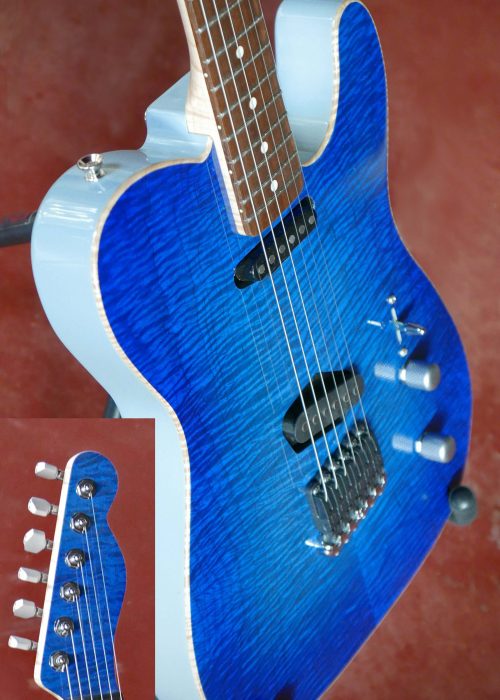 Tony Nobles "Coney Island Custom" Tele Guitar Master luthier Tony Nobles, based in Wimberly, Texas, needs little introduction. He’s been crafting custom guitars for years, quietly, without much hype, for artists ranging in style from Joe Walsh to Alejandro Escovedo. This guitar is fun, unique (it’s one of one), and draws on the DNA of some interesting sources. Starting with: the fretboard is made from rosewood salvaged from the actual Coney Island Boardwalk when they rebuilt it a few years ago. So it's a piece of history. Cut to chase on this unique guitar:
Tony Nobles "Coney Island Custom" Tele Guitar Master luthier Tony Nobles, based in Wimberly, Texas, needs little introduction. He’s been crafting custom guitars for years, quietly, without much hype, for artists ranging in style from Joe Walsh to Alejandro Escovedo. This guitar is fun, unique (it’s one of one), and draws on the DNA of some interesting sources. Starting with: the fretboard is made from rosewood salvaged from the actual Coney Island Boardwalk when they rebuilt it a few years ago. So it's a piece of history. Cut to chase on this unique guitar:- Top: bookmatched Maple; Natural Maple top binding
- Nitrocelulose lacquer finish
- Musikraft neck, maple, with rosewood fretboard made from salvaged wood from the actual Coney Island Boardwalk (when they tore down the old boardwalk for reconstruction, and the wood was preserved by architects/preservationists)
- 25.5" Scale
- Width at the Nut: 1-11/16"
- Width at the Heel: 2-3/16 (55.56mm)
- Number of Frets: 21
- Fret Type: Medium 6105
- Finger Board Radius: 10"
- Back of neck: natural, no finish
- Front of headstock, blue to match body
- Bridge: Schaller, imported from Germany, chrome
- Tuners: Sperzel Trimlok Locking Guitar Tuners 6-in-line Trim-Lok SATIN CHROME
- Volume and tone knobs: brushed satin chrome
- Pickups: Harmonic Design "54 special" for the bridge pickup; and Harmonic Design "MiniStrat" for the neck pickup
-
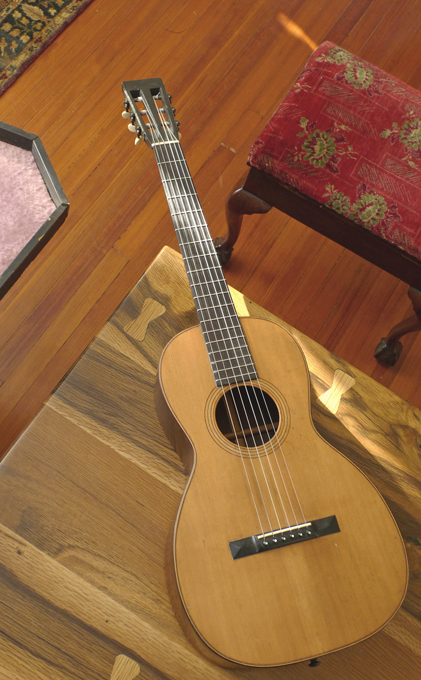 Another all-original pre-war Martin… but you have to go back a few more wars on this one- to just after the Civil War. This guitar even has its original coffin case–necessary in the days when Martin guitars were shipped out by railroad or wagon train. The figured Brazilian rosewood back and sides are unusual– in these decades of the 19th century (and through the middle of the 20th) Martin usually did not use this kind of figured, lovely Brazilian (they preferred the more straight-grained variety). On this guitar, for the sake of originality, we’ve kept its original saddle intact. The original ivory saddle is worn through at the strings, but still functions nicely.
Another all-original pre-war Martin… but you have to go back a few more wars on this one- to just after the Civil War. This guitar even has its original coffin case–necessary in the days when Martin guitars were shipped out by railroad or wagon train. The figured Brazilian rosewood back and sides are unusual– in these decades of the 19th century (and through the middle of the 20th) Martin usually did not use this kind of figured, lovely Brazilian (they preferred the more straight-grained variety). On this guitar, for the sake of originality, we’ve kept its original saddle intact. The original ivory saddle is worn through at the strings, but still functions nicely.- Fan braced
- Adirondack top
- Ebonized “ice cream cone” style neck
- Solid Brazilian rosewood back and sides
- 100% original finish…. No overspray, touch-up, etc. anywhere…wonderful finish
- Original ebony bridge, and bridge plate
- Two cracks in spruce top; one is bridge to bottom of top; the other is from near bridge to soundhole; first one described is beneath an internal brace; second is 2mm adjacent to a different brace. Neither need attention and are left alone to preserve originality.
- Characteristic, three Martin stamps: “CF Martin & Co, New York” ink stamped on neck block; “CF Martin & Co, New York” ink stamped on center strip inside; and “CF Martin New York”, stamped/pressed into brazilian rosewood back of guitar, up near the heel. (note: this guitar is not signed personally by factory foreman, etc, on underside of top…. This fact, and the other details, points to a circa 1870 date, not 1880s or 90’s).
-
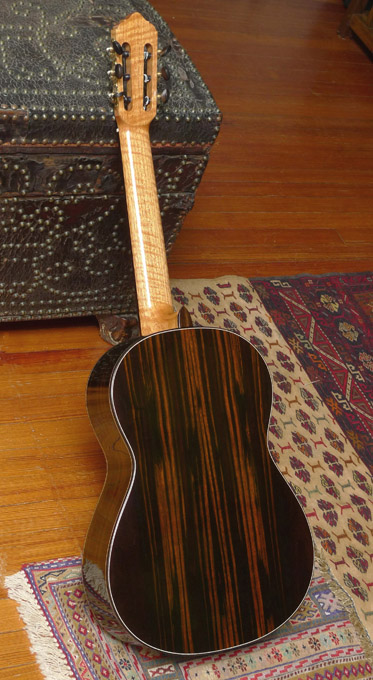 Vustom made Lester Devoe Flamenco Negra, a one-of-a-kind, Brazilian Rosewood guitar, from one of the world’s top luthiers. Lester Devoe needs no introduction to the world’s great Flamenco players. The late, legendary Sabicas played a Devoe– and converted some of the great Flamenco players in Spain to the fold. Paco De Lucia, and Vicente Amigo, among others, play Devoe Flamenco guitars. (I personally delivered a Devoe Flamenco Blanca guitar to Paco De Lucia in Spain in late 2010– Paco likes his Devoe’s hand-delivered. Paco De Lucia began playing a Devoe Negra guitar years ago– and there are many Paco De Lucia recordings and feature films where Paco plays a Devoe Flamenco guitar.) And it’s rare that Lester makes a Negra with Brazilian rosewood of this age and quality.
Vustom made Lester Devoe Flamenco Negra, a one-of-a-kind, Brazilian Rosewood guitar, from one of the world’s top luthiers. Lester Devoe needs no introduction to the world’s great Flamenco players. The late, legendary Sabicas played a Devoe– and converted some of the great Flamenco players in Spain to the fold. Paco De Lucia, and Vicente Amigo, among others, play Devoe Flamenco guitars. (I personally delivered a Devoe Flamenco Blanca guitar to Paco De Lucia in Spain in late 2010– Paco likes his Devoe’s hand-delivered. Paco De Lucia began playing a Devoe Negra guitar years ago– and there are many Paco De Lucia recordings and feature films where Paco plays a Devoe Flamenco guitar.) And it’s rare that Lester makes a Negra with Brazilian rosewood of this age and quality.- 650mm scale length
- Nut: 52mm
- Neck width at nut: 52mm
- String Spacing at nut: 44mm
- 80 year old Brazilian Rosewood (pre-CITES) back and sides (Quartersawn).
- European spruce top, with some beautiful and understated “"hazelfichte" (what Americans call bear claw).
- Custom, flamed Spanish Cedar neck
- Brazilian Rosewood headstock overlay, and bridge
- Brazilian Rosewood body binding, top and back
- Ebony fingerboard
- Sloane tuners
- Austere yet elegant Santos style black and white rosette, that Devoe uses only rarely, on top custom models
- Nitrocellulose lacquer finish